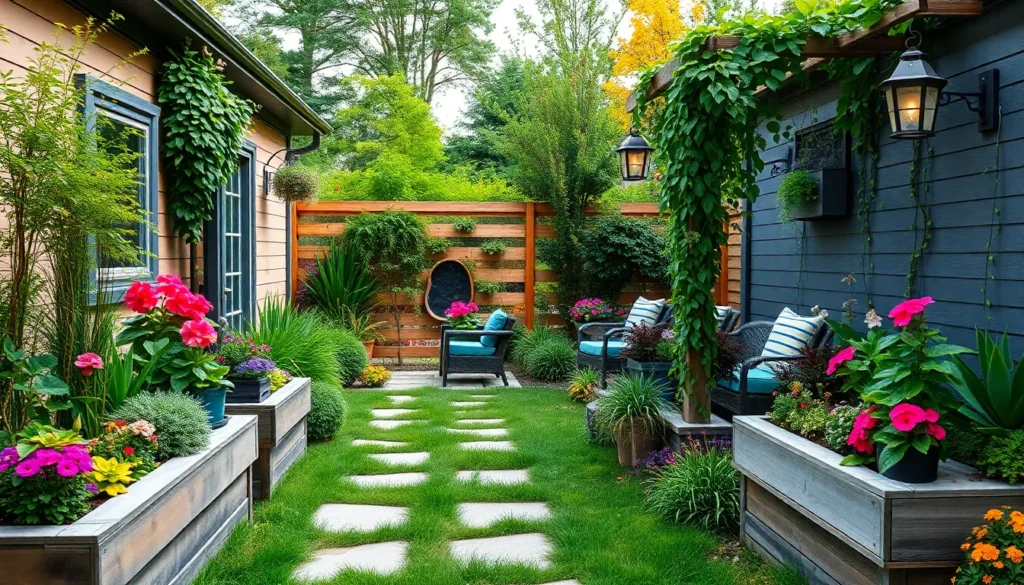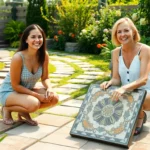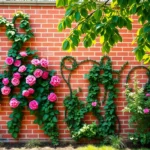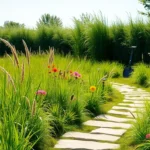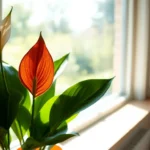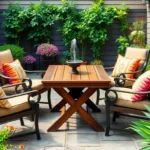Transform your outdoor space into a stunning sanctuary that reflects your personality and enhances your home’s value. We’ve all stood in our backyards wondering how to turn that blank canvas into something extraordinary – and that’s exactly where smart garden design comes into play.
Whether you’re working with a sprawling lawn or a cozy patio, the right design elements can completely revolutionize your outdoor experience. From creating intimate seating areas to establishing vibrant plant combinations, we’ll explore proven strategies that turn ordinary gardens into breathtaking retreats.
The best garden designs aren’t just beautiful – they’re functional spaces that serve your lifestyle needs while boosting your property’s appeal. We’re diving into creative answers that work for every budget and skill level, helping you create an outdoor oasis that you’ll love spending time in year after year.
Create a Stunning Entrance With Garden Gate Design Ideas
Your garden gate sets the stage for everything that follows in your outdoor sanctuary. We’ll explore three essential elements that transform ordinary entrances into captivating focal points.
Choose Materials That Complement Your Home’s Architecture
Wood gates offer timeless charm and pair beautifully with traditional or rustic home styles. Cedar and redwood naturally resist weather damage while developing attractive silver patinas over time. Metal gates provide sleek sophistication for contemporary homes and offer superior durability with minimal maintenance requirements.
Stone pillars flanking your gate create substantial visual weight and work exceptionally well with brick or stone exteriors. Wrought iron combines elegance with security and complements both Victorian and modern architectural styles. Composite materials deliver the appearance of wood without ongoing upkeep concerns.
Match your gate’s finish to existing outdoor elements like porch railings or window trim. Painted gates should coordinate with your home’s color palette while stained wood options can echo natural industry materials. Consider mixing materials such as wood panels within metal frames for unique visual interest.
Install Climbing Plants for Natural Beauty
Climbing roses transform plain gates into romantic focal points with their abundant blooms and sweet fragrances. English ivy provides year round coverage and creates lush green backdrops for seasonal plantings. Clematis vines offer dramatic purple or white flowers that cascade gracefully over gate structures.
Morning glories deliver vibrant blue or pink trumpet shaped flowers that open with the sunrise. Honeysuckle attracts hummingbirds and butterflies while filling evening air with delightful scents. Wisteria creates spectacular spring displays with drooping clusters of lavender or white blooms.
Install sturdy trellises or wire supports before planting to guide growth patterns effectively. Space climbing plants 18 to 24 inches apart for optimal coverage without overcrowding. Regular pruning maintains healthy growth and prevents vines from overwhelming gate hardware or hinges.
Add Lighting for Evening Appeal
Solar powered lanterns mounted on gate posts eliminate wiring concerns while providing soft ambient illumination. LED strip lights hidden beneath gate caps create subtle uplighting that highlights architectural details. Motion sensor fixtures enhance security while automatically welcoming guests after dark.
Low voltage industry lighting positioned near the gate entrance extends usable outdoor time. String lights draped between posts or wound through climbing plants add festive charm for entertaining. Pathway lights leading to and from your gate ensure safe navigation during evening hours.
Consider warm white LED bulbs rated at 2700K to 3000K for inviting golden tones. Timer controls automatically manage lighting schedules while conserving energy during daylight hours. Weatherproof fixtures rated for outdoor use prevent moisture damage and ensure reliable operation.
Design a Functional Pathway Through Your Garden Space
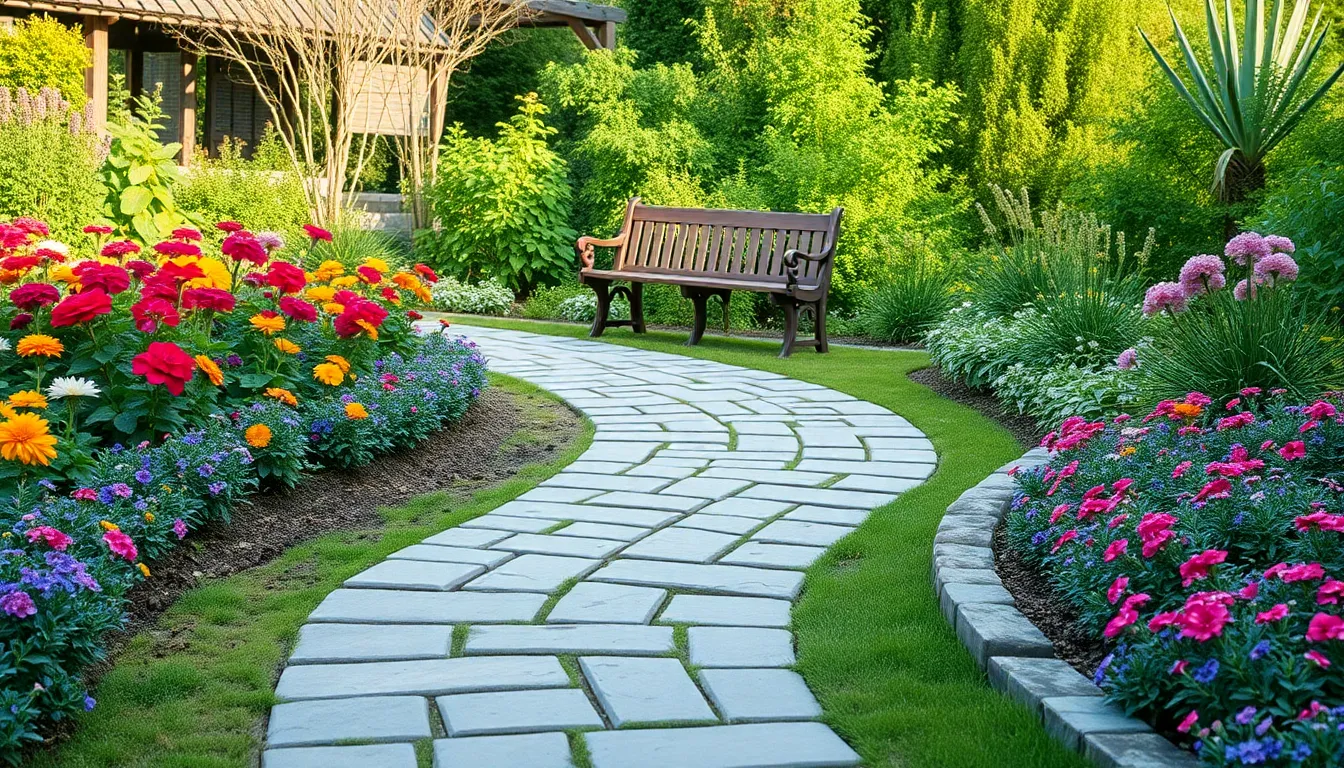
A well-designed pathway transforms your garden into an accessible and visually appealing outdoor sanctuary. Our pathway design connects different areas of your garden while creating a natural flow that guides visitors through your carefully curated industry.
Select Durable Materials for High-Traffic Areas
Durable materials ensure your garden pathway withstands constant foot traffic and seasonal weather changes. We recommend choosing from several proven options that combine longevity with aesthetic appeal.
Wooden boardwalks work exceptionally well for slopes or areas with poor drainage, with cedar and redwood offering natural rot resistance that lasts for decades. Composite materials provide even greater durability while maintaining the natural wood appearance many homeowners prefer.
Gravel pathways deliver excellent drainage properties and create a pleasant sensory experience as you walk through your garden. These materials suit cottage style gardens and Mediterranean landscapes particularly well, offering both functionality and authentic charm.
Brick and pavers represent the most durable long term solution for high traffic garden areas. We’ve found these materials especially effective in English cottage style gardens where traditional aesthetics matter as much as practical performance.
Incorporate Curves for Visual Interest
Curves transform ordinary garden pathways into ever-changing industry features that capture attention and create mystery. We design curved pathways to lead visitors toward focal points like water features, sculpture displays, or specialized garden rooms.
Gentle S-curves work particularly well in larger garden spaces, allowing us to showcase different planting areas while maintaining natural flow patterns. These curves prevent visitors from seeing the entire pathway at once, building anticipation for what lies ahead.
Destination focused curves guide people toward exact garden features like seating areas, pergolas, or ornamental trees. We position these curves to frame views and create natural stopping points throughout your outdoor space.
Plan Proper Width for Accessibility
Proper pathway width ensures comfortable navigation while accommodating multiple users simultaneously. We design our garden pathways to meet both practical needs and aesthetic goals.
Standard pathways require a minimum width of 3 feet to allow two people to walk side by side comfortably. This measurement works well for primary routes connecting major garden areas like patios, gazebos, and entrance gates.
Stepping stone paths need careful spacing between individual stones, typically 18 to 24 inches apart for comfortable stride patterns. We adjust these measurements based on the average height of family members who’ll use the pathway most frequently.
Secondary pathways can be narrower at 2 feet wide when they lead to less frequently visited garden areas like compost bins, tool sheds, or quiet meditation spots.
Establish Focal Points With Eye-Catching Garden Features
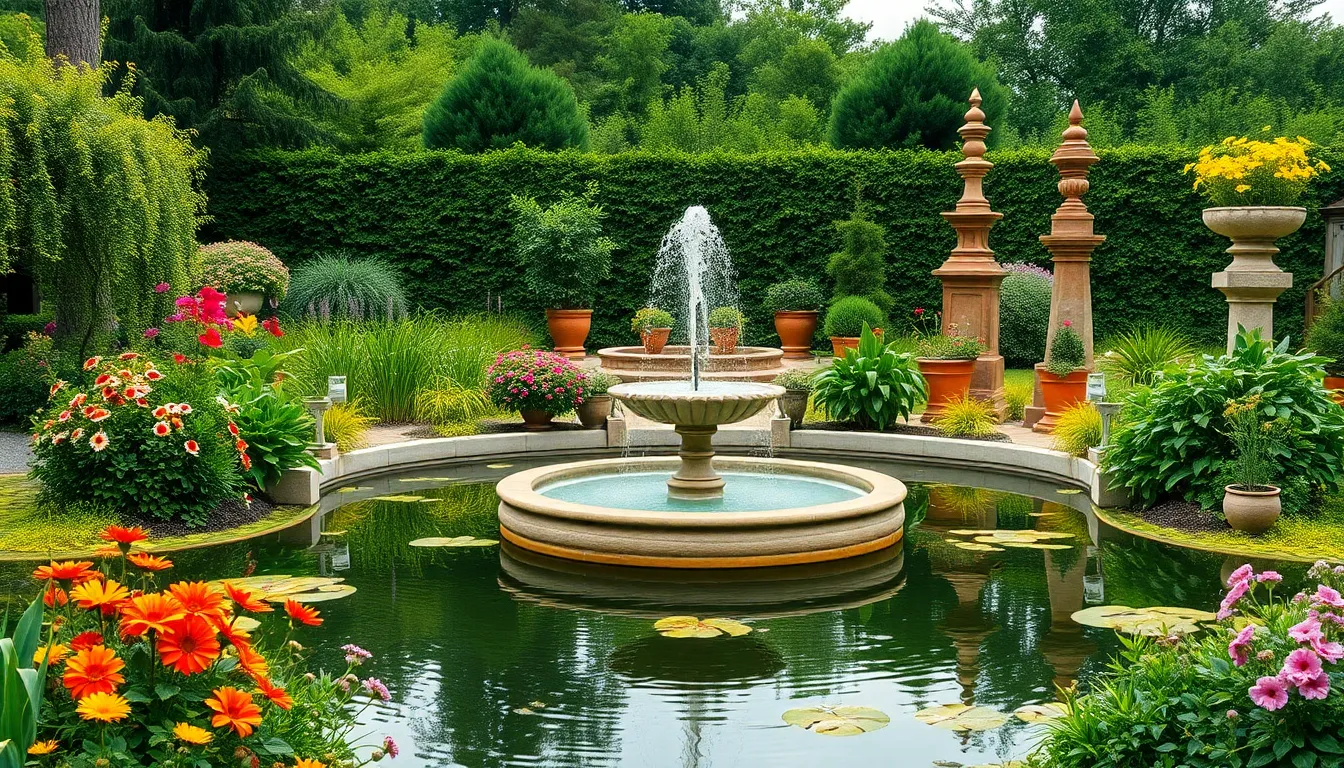
Creating strategic focal points transforms any garden space from ordinary to extraordinary by drawing the eye and establishing visual hierarchy throughout your industry design.
Install Water Features for Tranquil Ambiance
Ponds create serene gathering spots that naturally attract wildlife while adding reflective surfaces to enhance your garden’s visual depth. Small pond installations work perfectly in corner spaces or alongside seating areas where we can enjoy the gentle sounds of moving water.
Fountains serve as ever-changing centerpieces that combine visual appeal with soothing audio elements to mask neighborhood noise. We recommend positioning fountains at pathway intersections or within view of indoor living spaces to maximize their impact throughout the day.
Bird baths offer shallow water features that invite feathered visitors while requiring minimal maintenance compared to larger installations. These versatile elements work beautifully when placed among flowering plants or positioned to catch morning sunlight for optimal bird activity.
Create Garden Sculptures as Conversation Starters
Simple forms like obelisks anchor formal garden beds with timeless elegance that complements both traditional and contemporary industry designs. We often place these sculptural elements at the center of geometric planting schemes to create strong vertical interest.
Themed sculptures reflect personal interests while adding unique character that distinguishes your outdoor space from neighboring gardens. Artists create pieces inspired by nature, abstract concepts, or cultural themes that resonate with individual homeowners’ personalities.
Natural materials including wood and stone blend seamlessly with existing industry elements while providing earthy textures that age gracefully over time. These organic sculptures complement planted areas without competing for attention or overwhelming smaller garden spaces.
Build Raised Planters for Dimensional Interest
Tiered planters create layered displays that showcase different plant varieties at varying heights for maximum visual impact. We construct these multi level systems using retaining materials that match existing hardscape elements throughout the property.
Wooden planters bring rustic charm to garden designs while offering excellent drainage and customizable sizing options for exact planting needs. Cedar and redwood materials resist weather damage while developing attractive patina that enhances their natural appearance over several seasons.
Integrated seating combines functional design with planting opportunities by incorporating bench elements into raised planter construction. These dual purpose features work especially well in smaller spaces where we need to maximize both growing area and comfortable gathering spots for family activities.
Plan Your Plant Layout Using Color and Texture Combinations
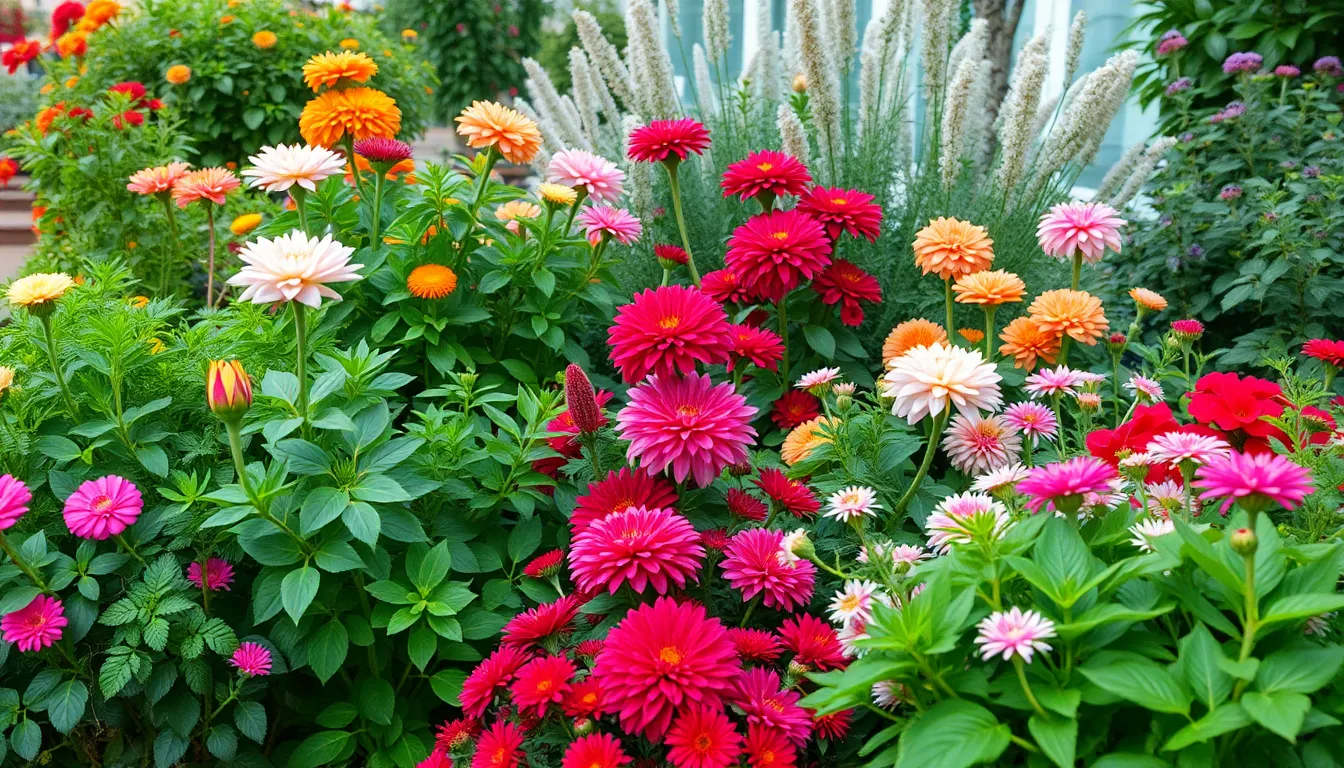
Creating a cohesive plant layout requires thoughtful consideration of how colors and textures work together throughout your garden space. We’ll explore strategic approaches to achieve continuous visual interest while maintaining harmony across seasons.
Group Plants by Bloom Time for Continuous Color
Seasonal blooms ensure your garden maintains vibrant colors from spring through fall by strategically timing different flowering periods. We recommend incorporating early bloomers like crocuses and daffodils for spring color, followed by summer favorites such as roses and delphiniums, then finishing with autumn performers like chrysanthemums and asters.
Layered blooms create depth by combining plants with overlapping flowering schedules that extend the color display. Planning your garden with early, mid-season, and late bloomers guarantees that as one variety fades, another takes center stage to maintain continuous visual appeal.
Color wheel principles help us select harmonious combinations that complement rather than compete with each other. Pastel colors work exceptionally well together and provide gentle contrast against plants with silver or gray foliage, creating sophisticated color schemes that feel natural and balanced.
Mix Foliage Textures for Year-Round Appeal
Foliage variety forms the backbone of your garden’s structure by incorporating evergreen, deciduous, and flowering plants that maintain interest even when blooms fade. We suggest combining broad-leaved hostas with needle-textured conifers and delicate ferns to create compelling contrasts that engage the eye year-round.
Texture contrasts add visual depth through strategic combinations of smooth leaves, rough bark surfaces, and soft flower petals that create tactile interest. Mixing plants like glossy magnolia leaves with fuzzy lamb’s ear and spiky ornamental grasses produces ever-changing landscapes that invite closer inspection.
Structural elements emerge when we combine different growth habits such as upright grasses, spreading groundcovers, and cascading vines. These varied forms create natural sculptural qualities that enhance the garden’s architectural appeal beyond traditional flower displays.
Consider Plant Heights for Layered Landscapes
Layered planting utilizes varying heights to create dimensional interest with taller specimens in background positions and shorter plants positioned in foreground areas. We position trees and large shrubs at 8-12 feet as backdrop elements, medium plants at 3-6 feet for middle ground interest, and low-growing varieties under 2 feet for front border definition.
Visual flow maintains healthy growing conditions by ensuring taller plants don’t obstruct sunlight from reaching shorter companions positioned in front. Strategic placement allows each plant to receive adequate light while contributing to the overall composition’s balanced appearance.
Height transitions create smooth progressions rather than abrupt changes that can appear jarring or unnatural in the industry. Graduating plant heights in gentle steps helps guide the eye naturally through the garden space while maintaining proportional relationships between different plant groupings.
Create Outdoor Living Spaces Within Your Garden Design
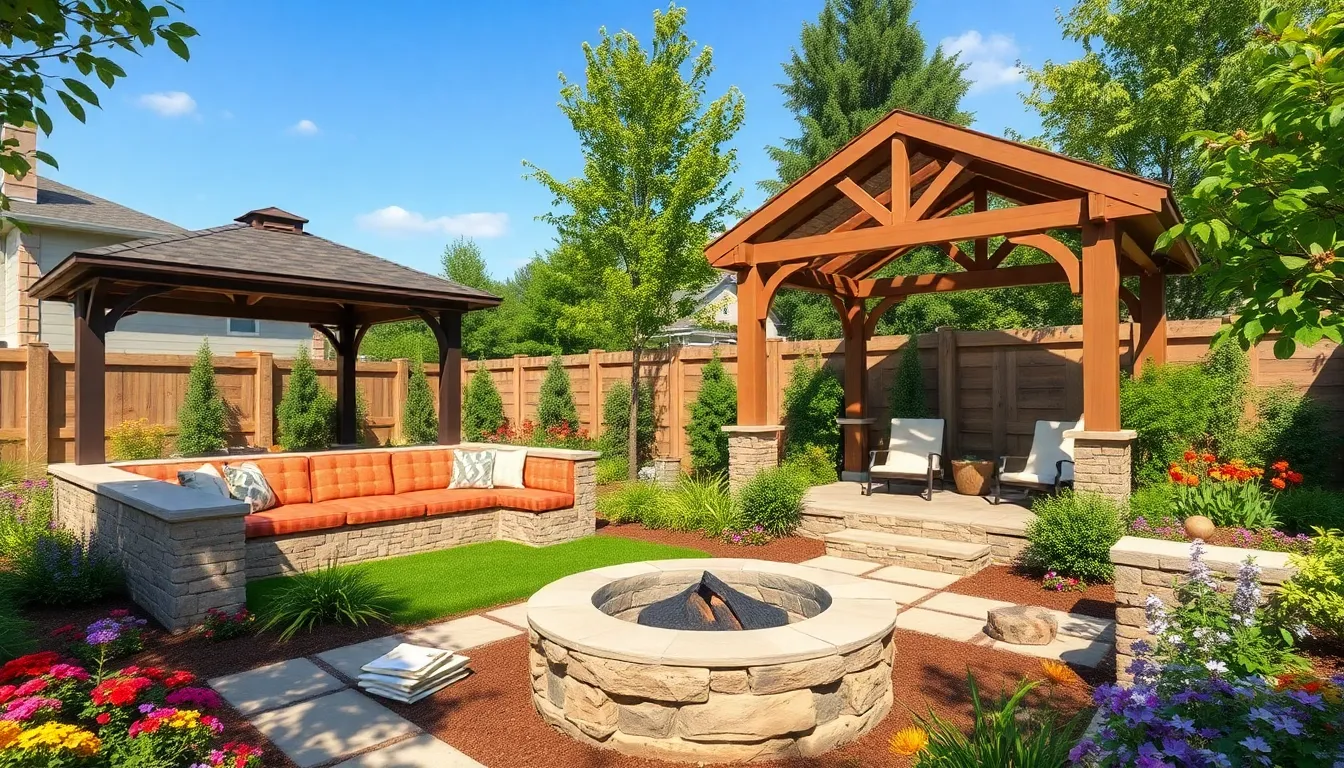
Contemporary garden design emphasizes creating functional outdoor extensions of our homes. We’re designing gardens as versatile spaces that serve both daily relaxation and social entertainment needs.
Design Seating Areas for Relaxation and Entertainment
Built-in benches integrated with plantings maximize space efficiency while creating seamless garden flow. We position these permanent seating options along garden borders or around raised planters to blend functionality with industry design.
Movable furniture offers flexibility for different occasions and seasonal changes. Outdoor sofas, lounge chairs, and dining sets allow us to reconfigure spaces based on guest numbers or weather conditions.
Strategic placement takes advantage of natural features and garden views. We locate seating areas where they’ll capture morning sunlight, evening breezes, or prime views of focal points like water features or flower beds.
Comfortable materials encourage longer outdoor stays and enhance entertainment value. Weather-resistant cushions, all-weather fabrics, and ergonomic designs ensure our guests want to linger in the garden.
Install Pergolas or Gazebos for Shade and Structure
Pergolas define outdoor rooms while supporting climbing plants for natural beauty. These open-roof structures create partial shade and architectural interest without blocking airflow or completely enclosing spaces.
Gazebos provide complete shelter from sun and light rain for year-round use. We choose gazebos when we need fully covered spaces for dining or entertaining regardless of weather conditions.
Material options range from traditional wood to modern metal and recycled composites. Cedar and teak offer natural weather resistance, while aluminum and steel provide low-maintenance durability for contemporary designs.
Plant integration transforms structures into living garden features. Climbing roses, jasmine, wisteria, and grape vines create natural canopies that change with seasons and add fragrance to our outdoor spaces.
Add Fire Features for Extended Seasonal Use
Fire pits create cozy gathering spots that extend garden use into cooler months. Portable metal fire pits offer flexibility, while permanent stone installations become lasting focal points that anchor seating arrangements.
Outdoor fireplaces provide substantial warmth and dramatic visual impact. These permanent features create intimate outdoor rooms and serve as natural gathering points for larger groups during fall and winter evenings.
Safety considerations ensure proper placement and ventilation for all fire features. We maintain adequate clearance from structures, overhanging branches, and seating areas while following local fire codes and regulations.
Fuel options include wood-burning, propane, and natural gas systems for different needs. Wood fires create authentic ambiance with crackling sounds and natural scents, while gas options offer convenience and consistent heat output.
Incorporate Sustainable Elements Into Your Garden Design
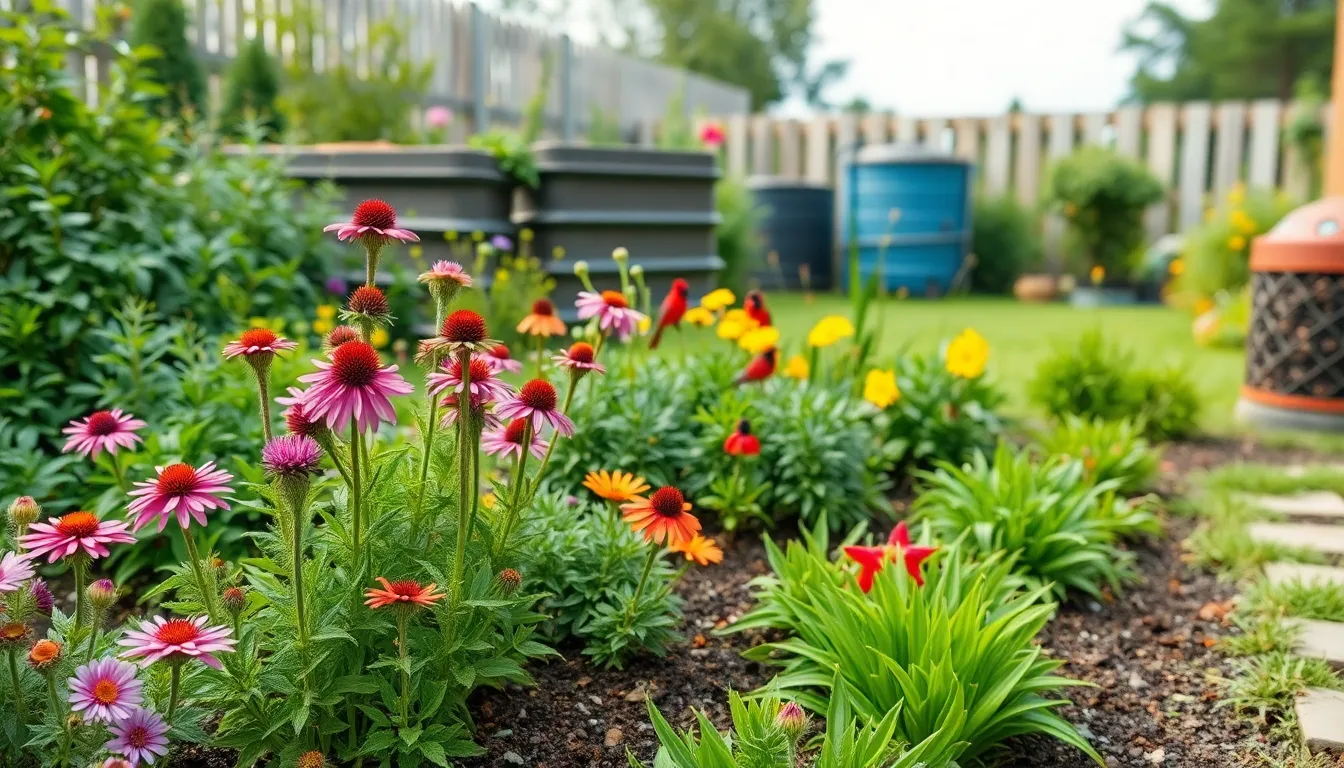
Building on our functional outdoor living spaces, we can enhance our gardens with eco-friendly features that reduce environmental impact while creating stunning landscapes. Sustainable garden design combines beauty with responsibility, offering long-term benefits for both our outdoor spaces and the planet.
Choose Native Plants for Low-Maintenance Beauty
Native plants form the foundation of sustainable garden design because they’re naturally adapted to local soil and weather conditions. These plants require significantly less water than non-native varieties and eliminate the need for chemical fertilizers, reducing both maintenance costs and environmental impact.
We recommend researching plants indigenous to our exact region through local extension offices or native plant societies. Examples include purple coneflowers in the Midwest, California poppies on the West Coast, or black-eyed Susans in the Southeast. Native species also support local wildlife by providing food sources for birds, butterflies, and beneficial insects that maintain healthy garden ecosystems.
Beyond their environmental benefits, native plants offer exceptional drought tolerance and disease resistance. They conserve water naturally, preserve biodiversity, and create authentic regional character in our landscapes without requiring constant intervention or costly inputs.
Install Rain Gardens for Water Management
Rain gardens transform problematic drainage areas into attractive industry features that manage stormwater runoff effectively. These specially designed depressions use natural slopes and strategically placed berms to capture and direct rainwater, allowing it to slowly infiltrate the soil rather than rushing into storm drains.
We position rain gardens in low-lying areas where water naturally collects, typically 10 to 30 feet from building foundations. The design incorporates native plants with deep root systems that can handle both wet and dry conditions, such as cardinal flower, blue flag iris, or native sedges.
Proper installation involves creating a shallow depression approximately 6 to 8 inches deep with gently sloping sides. Rain gardens filter pollutants from runoff water while recharging groundwater supplies and reducing erosion. They conserve water resources, support healthier local ecosystems, and eliminate standing water issues that attract mosquitoes.
Create Composting Areas for Organic Gardening
Composting areas convert kitchen scraps and yard waste into nutrient-rich soil amendments that enhance garden health naturally. We design these spaces using three-bin systems or tumbler composters that accommodate different stages of decomposition while maintaining neat appearances in our landscapes.
Effective composting requires balancing carbon-rich materials like dried leaves and paper with nitrogen-rich materials such as vegetable scraps and grass clippings. We locate composting areas in partially shaded spots with good drainage and easy access from both kitchen and garden areas.
Finished compost provides essential nutrients from organic materials, eliminating the need for chemical fertilizers while improving soil structure and water retention. This practice reduces household waste significantly, enhances soil health, and creates a closed-loop system that supports vigorous plant growth throughout our sustainable gardens.
Design Vertical Gardens to Maximize Limited Space
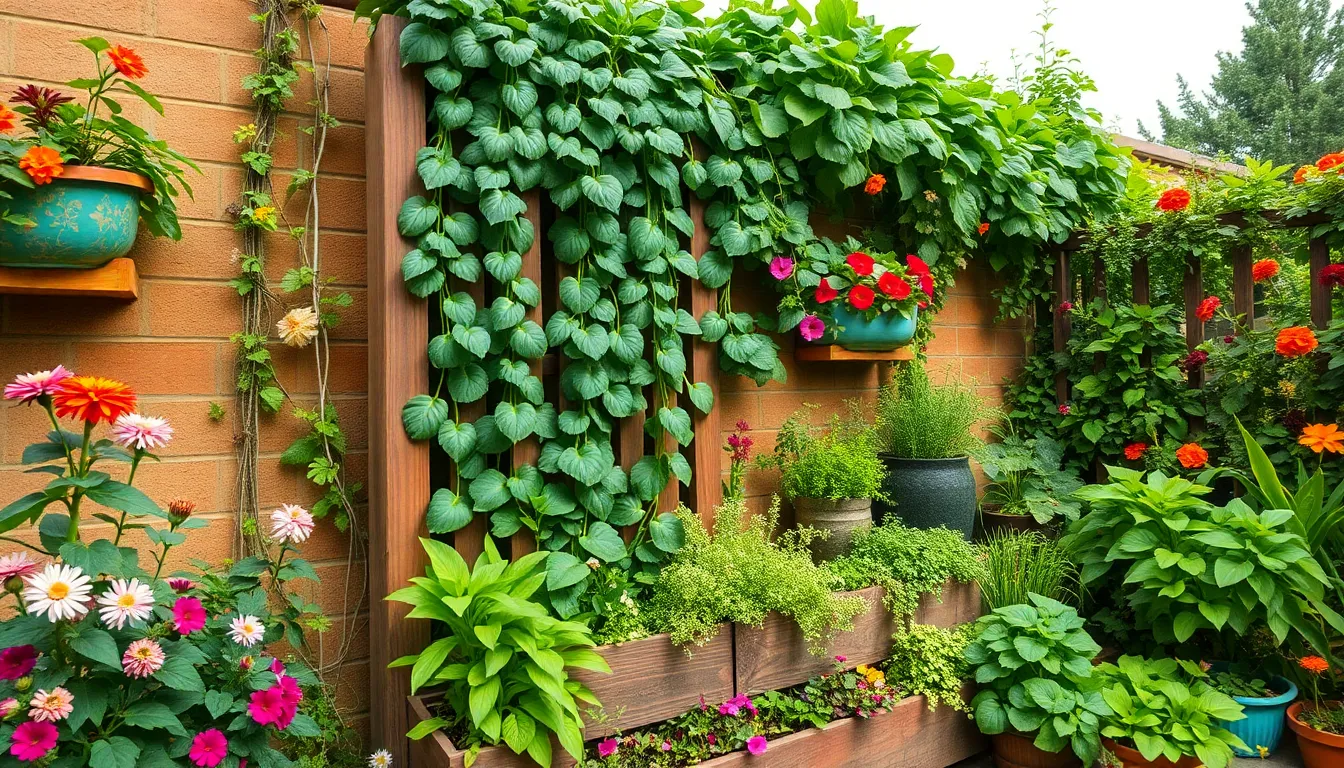
Vertical gardening transforms limited outdoor areas into productive growing spaces that climb upward instead of spreading outward. We’ll explore three effective approaches to create stunning vertical displays that maximize every square foot of your garden.
Build Living Walls for Small Garden Areas
Living walls use pocket pouches or containers attached to existing walls and fences to create lush vertical displays. We recommend installing these systems on sturdy surfaces that can support the weight of soil and water while providing adequate drainage.
Container-based living walls offer flexibility for renters or those wanting temporary installations. Mount modular planting systems directly onto fence posts or wall brackets to create customizable growing arrangements. These systems work exceptionally well for herbs like basil and oregano that you can harvest regularly.
Flowering plants mixed with foliage varieties create visual appeal throughout growing seasons. We suggest combining trailing petunias with upright marigolds and cascading ivy for continuous color and texture. This combination provides blooms from spring through fall while maintaining green interest during transitional periods.
Install Trellises for Climbing Plant Support
Teepee trellises provide simple yet effective support for vining plants like pole beans and hops. We create these structures using three to four wooden rods or branches tied together at the top, forming a cone shape that plants can climb naturally. This design works particularly well for edible gardens where you want easy harvest access.
Cattle panels offer inexpensive trellising answers for cucumbers and luffa varieties. These sturdy metal grids attach easily to fence posts or garden stakes while providing many climbing points for vigorous vines. We’ve found them especially useful for heavy producers that need substantial support throughout the growing season.
A-frame trellises deliver additional stability for climbing plants in windy locations. Build these structures by connecting two triangular frames with horizontal supports, creating a tunnel effect that plants can climb on both sides. This design maximizes growing space while providing wind protection for delicate vines.
Create Tiered Planters for Multiple Growing Levels
Multi-tiered container gardens stack growing containers to create vertical herb and vegetable displays. We arrange different sized pots in pyramid formations, placing larger containers at the bottom and smaller ones on top. This system allows for diverse plantings while ensuring adequate sunlight reaches all levels.
Ladder planters repurpose old wooden ladders by adding hooks and shelves for vertical growing against walls or fences. Mount planters at different rungs to create a staggered effect that showcases various plant heights and textures. We recommend securing ladders firmly to prevent tipping when containers are fully watered.
Stepped planter boxes create dramatic visual impact while maximizing growing area in compact spaces. Build these systems with progressively smaller boxes placed on top of larger ones, ensuring each level receives adequate light exposure. This design works particularly well for strawberry plants and cascading flowers that benefit from elevation.
Add Lighting Solutions to Extend Garden Enjoyment
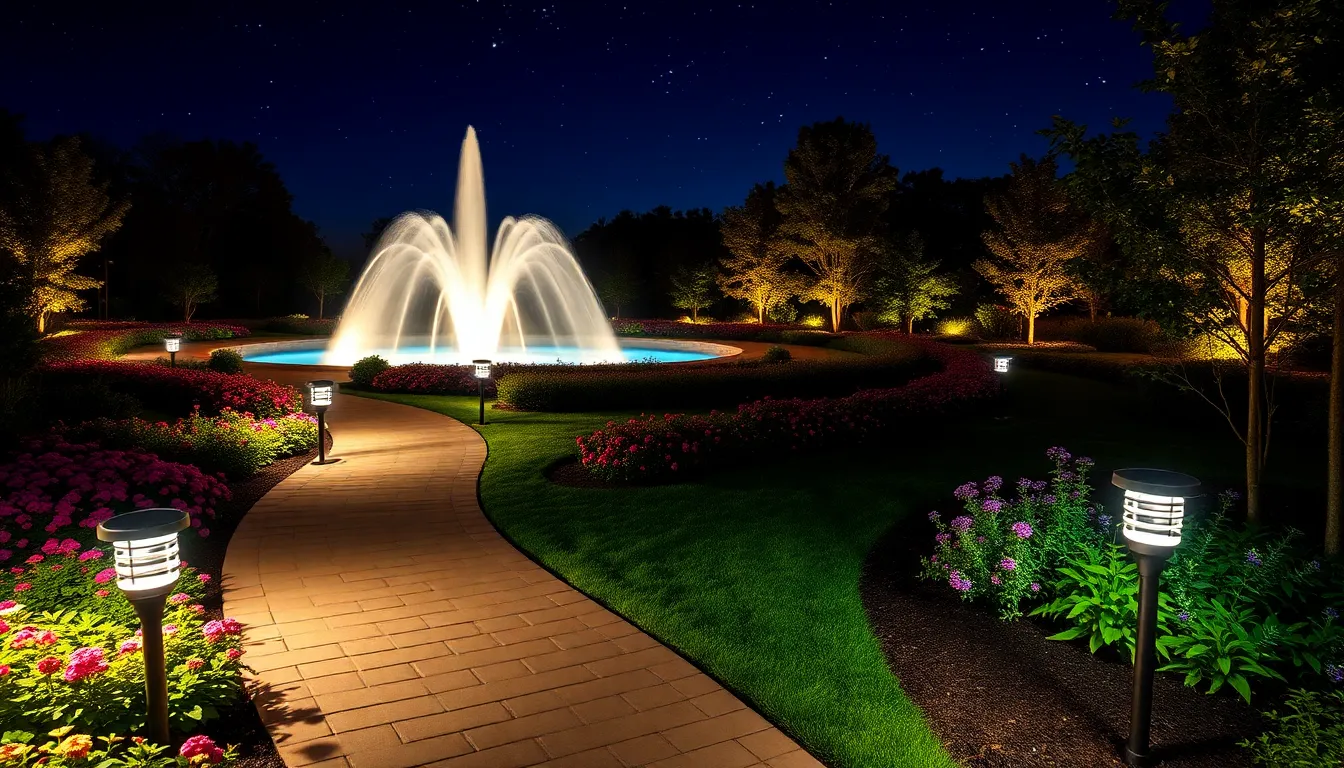
Strategic lighting transforms our garden spaces into captivating nighttime destinations that extend usability well beyond daylight hours. We can create magical outdoor environments that invite evening relaxation and entertaining through thoughtful illumination choices.
Install Path Lighting for Safety and Navigation
Path lighting ensures safe movement through our garden spaces while creating enchanting visual guides that enhance the overall ambiance. We recommend installing solar powered stake lights along primary walkways to provide consistent illumination without complex electrical installations. LED pathway lights offer superior durability and energy efficiency, lasting significantly longer than traditional bulb options while consuming minimal power.
Strategic placement creates optimal lighting coverage by positioning fixtures every 6 to 8 feet along curved pathways and garden borders. We can achieve professional results by maintaining consistent height levels and ensuring lights don’t create harsh glare that disrupts the peaceful garden atmosphere. Ground level installations work particularly well for highlighting stepping stones, wooden boardwalks, and gravel paths without overwhelming surrounding plantings.
Use Accent Lighting to Highlight Key Features
Accent lighting showcases our garden’s most stunning elements by drawing attention to focal points that might otherwise disappear after dark. We can transform water features like fountains and ponds into mesmerizing centerpieces using underwater LED systems or strategically positioned spotlights that create dramatic reflections. Uplighting techniques work exceptionally well for highlighting garden sculptures, ornamental trees, and architectural elements like gazebos or pergolas.
Backlighting creates striking silhouettes by positioning lights behind potted trees, tall grasses, or decorative screens to produce depth and visual interest. We achieve layered lighting effects by combining different techniques, such as spotlighting a garden statue while using softer illumination to highlight surrounding flower beds. String lights wrapped around pergola structures or tree branches add festive warmth that encourages outdoor gathering and conversation.
Choose Solar Options for Eco-Friendly Illumination
Solar powered lighting provides sustainable illumination that reduces energy consumption while eliminating the need for complex electrical wiring throughout our garden spaces. We can install these eco friendly fixtures anywhere sunlight reaches during daytime hours, allowing for flexible placement that follows our garden’s evolving design needs. Modern solar panels integrated into lighting fixtures charge efficiently even during partially cloudy conditions, ensuring reliable operation throughout most evening hours.
Energy efficient LED fixtures combined with solar technology offer the longest operational life while minimizing environmental impact compared to traditional lighting systems. We benefit from significantly reduced electricity costs since solar lights operate independently from our home’s power grid after initial installation. Weather resistant solar options withstand seasonal temperature changes and moisture exposure, providing dependable performance that matches the durability of our other garden investments.
Conclusion
We’ve covered everything you need to transform your outdoor space into a stunning garden sanctuary. From creating welcoming entrances and functional pathways to incorporating sustainable practices and vertical growing answers your garden can become both beautiful and practical.
Remember that great garden design doesn’t happen overnight. Start with one or two elements that excite you most whether it’s installing pathway lighting or building a raised planter bed. Each improvement builds upon the next creating a cohesive outdoor retreat.
Your garden should reflect your personal style while serving your family’s needs. With these design strategies you’re well-equipped to create an outdoor space that you’ll enjoy for years to come. Take your time plan thoughtfully and watch your garden dreams come to life.
Frequently Asked Questions
What are the key elements of smart garden design?
Smart garden design focuses on creating functional and beautiful outdoor spaces through thoughtful planning of seating areas, plant combinations, and pathways. Key elements include choosing appropriate materials that complement your home’s architecture, incorporating focal points like water features or sculptures, and designing accessible pathways with proper width and durable materials for high-traffic areas.
How do I choose the right materials for my garden gate?
Select gate materials that complement your home’s architectural style. Popular options include wood for a natural look, metal for durability and modern appeal, and stone for timeless elegance. Consider your budget, maintenance requirements, and local climate when making your choice. You can enhance any material by adding climbing plants like roses or ivy.
What materials work best for garden pathways?
Durable pathway materials include wooden boardwalks, composite materials, gravel, brick, and pavers. Each offers unique benefits: wood provides warmth, composite requires low maintenance, gravel allows drainage, and brick or pavers offer classic appeal. Choose based on your traffic needs, budget, and desired aesthetic while ensuring proper width for comfortable navigation.
How can I create effective focal points in my garden?
Create focal points using water features like ponds or fountains, garden sculptures made from natural materials, bird baths for wildlife attraction, and raised planters for dimensional interest. These elements serve as visual anchors and conversation starters. Position them strategically to guide visitors’ eyes and create a sense of visual hierarchy throughout your space.
What’s the best approach to planning plant layouts?
Plan plant layouts by grouping plants with similar bloom times, applying color wheel principles for harmonious combinations, and mixing foliage textures for year-round appeal. Layer plants by height with taller specimens in back and shorter ones in front. Consider seasonal interest and create continuous color by selecting plants that bloom at different times throughout the year.
How do I design functional outdoor living spaces?
Design functional outdoor living spaces by creating flexible seating areas with built-in benches and movable furniture. Add pergolas or gazebos for shade and structure, and consider fire features like fire pits to extend usability into cooler months. Position seating strategically to maximize views and comfort while ensuring easy movement between different areas.
What sustainable elements can I incorporate into my garden?
Incorporate sustainable elements by using native plants that require less water and support local wildlife, installing rain gardens for stormwater management, and creating composting areas to convert kitchen scraps into nutrient-rich soil. These eco-friendly features reduce environmental impact while enhancing your garden’s beauty and reducing maintenance requirements.
How can I maximize small outdoor spaces with vertical gardening?
Maximize small spaces through vertical gardening techniques like building living walls, using container-based systems for flexibility, and installing trellises for climbing plants. Multi-tiered planters showcase various plant heights and textures while ensuring adequate sunlight exposure. These solutions create more growing space without expanding your garden’s footprint.
What lighting options work best for gardens?
Effective garden lighting includes path lighting with solar-powered stake lights or LED pathway lights for safety and navigation. Add accent lighting to highlight water features and sculptures, and consider solar options for eco-friendly illumination. Strategic lighting placement creates captivating nighttime environments while extending your garden’s usability after dark.

